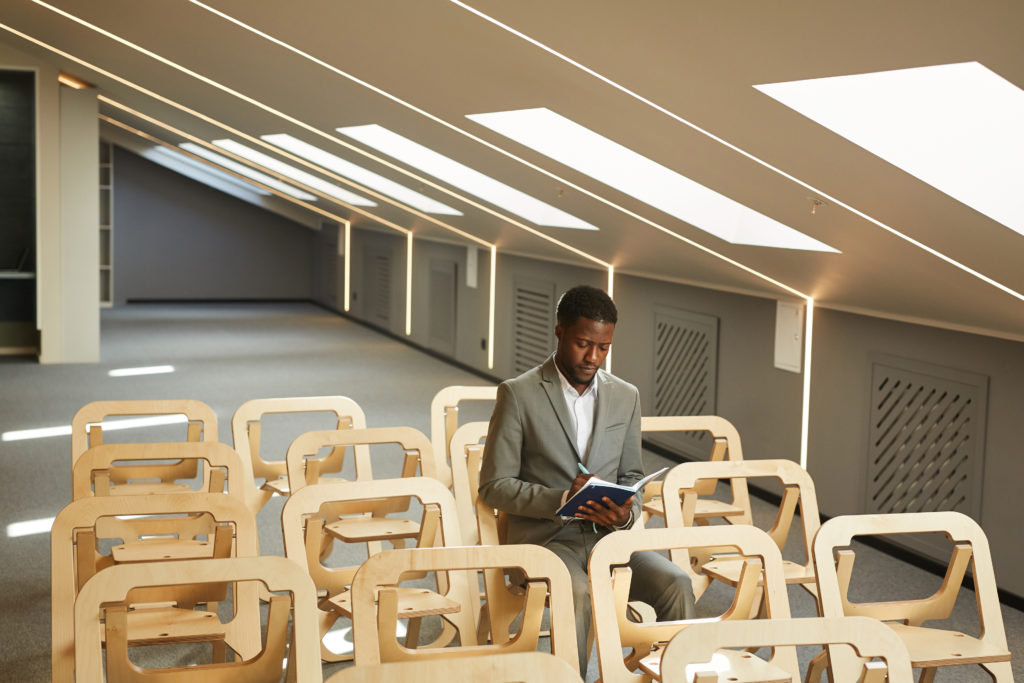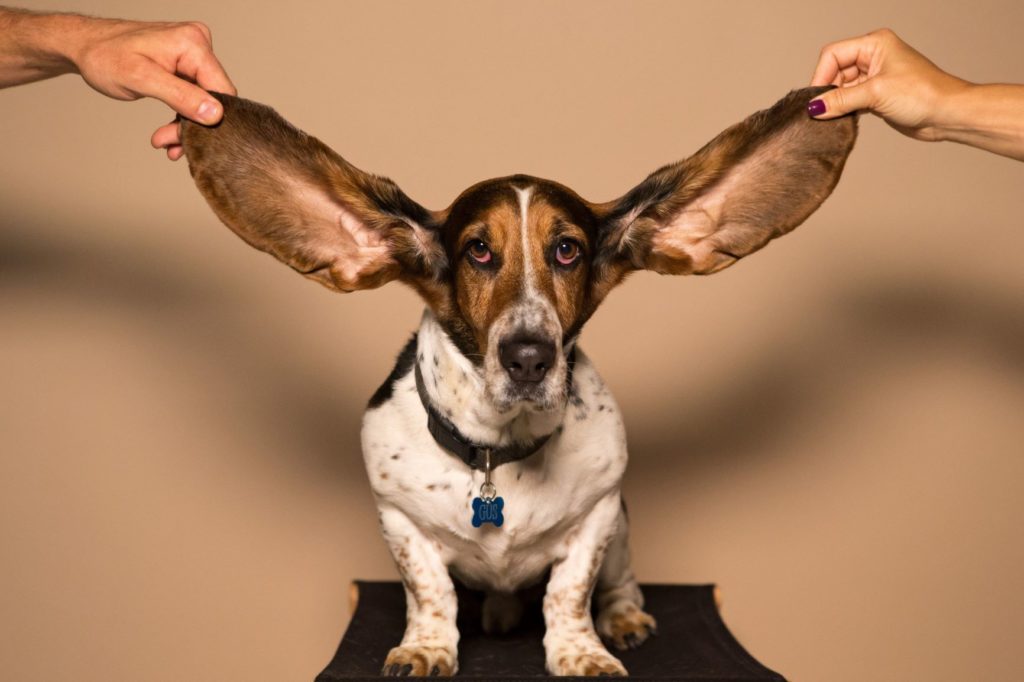Speaking Environment Part 1: The Room, Setup, and Other Considerations

Photo credit: Matthew Osborn/Unsplash.com
As a presenter, it’s crucial that you give your speaking environment the same kind of attention you give to the content of your talk. Presentation logistics – including the room, the seating layout, the temperature, your audio and video tools, and more – play a critical role in the success of your presentation.
In most cases, you’ll have at least some influence over those considerations, and you should exert it to ensure the audience is as comfortable and receptive to your ideas as possible.
This post begins a four-part series that focuses on how to best prepare for and approach your speaking environment – from the room setup to your timing, as well as other considerations – so that your presentation is heard and experienced exactly as you intended.
We begin with some space-related elements that can affect the way your audience experiences your talk.
4 Ways to Improve Your Speaking Environment
1. Choose the Right Room
I once saw a band play at New York City’s 21,000-seat Madison Square Garden. The group was past their peak popularity and, unfortunately for them, they performed in an arena that was more than half empty. It was sad to see the one-time radio staple reduced to playing for thousands of empty plastic chairs.
Imagine if they had booked a smaller venue instead? The concert hall would have been sold out, the audience would have felt electrified, and the fans would have left feeling good that their favorite musicians could still pack a room.
That example highlights the decisive factor when selecting a room – you want one that places people as closely together as possible, but with just enough space between each person to ensure their comfort. (We look forward to being able to do that again post-pandemic!) It’s difficult to build an intimate rapport in a vast room with hundreds of square feet of unused space. (If you don’t have any say regarding the room selection, you may be able to influence the seating arrangement, which can help. We’ll say more about that in the next post.)

2. Be Wary of Environmental Factors
You’re probably familiar with the dreaded “war of the thermostat.” You like it cold; your co-worker likes it warm. You crank the heater in the autumn; your roommate throws open the windows to bring in crisp outside air.
While you may not be able to create the ideal room temperature for everyone, your goal is to create a space as conducive to the audience’s ability to receive your message as possible. High temperatures can negatively impact people’s moods, even triggering anger and hostile thoughts. Low temperatures, which multiple studies find are more uncomfortable for women than men, can come at the cost of productivity.
Rooms set to between 71- and 76-degrees Fahrenheit (about 22- to 24-degrees Celsius) are usually right on the money.
3. Head off Distractions
I once gave a talk in a hotel conference room. One room over, the guests were being led in a drum circle (long story). With only a thin wall separating us, it was virtually impossible to stick to my original plan – so we called for a break, migrated into the hallway, and finished our session there.
Hopefully, you won’t face such a massive distraction. But anticipating what could go wrong allows you to help mitigate risks, as the examples below demonstrate:
- If loud sounds such as construction work or hallway music pose a threat to audience attention, ask the building manager or hotel staff to help halt the noises.
- If the room in which you’re speaking has a beverage station, ask the catering manager not to refresh or clean it during your talk (I’ve had audiences distracted by banging glasses and poured ice).
- If you’re speaking in a room that has large glass walls or windows, stand on the opposite side so audience attention remains on you, not the passersby on the other side of the pane.
Finally, avoid standing near the exit or entryway. It’s like being near the kitchen or bathroom in a restaurant. Every time someone arrives late or leaves to take a break, you must reengage your audience’s attention.
4. Adjust the Lighting
In general, avoid putting the audience in the dark or semi-darkness. Doing so makes it easy for them to zone out and makes it difficult for you to encourage interaction or elicit questions.
The lighting should allow the audience to see you clearly and, if appropriate for your event, have enough illumination to take notes or read handouts. If you’re displaying visuals, test your slides before the audience arrives to make sure the lighting isn’t washing out the screen. If necessary, dim the lights near the screen to create a sharper image.
Finally, technology allows most presentations to be displayed without the need for a projector. But if you do need one, ask that it be placed toward the front of the room. If it is too far back, you run the risk of being awash in light, blocking the screen, and having light beaming into your eyes.

Photo by Charles Deluvio on Unsplash
Presentation Preparation is Key
You may have a greater influence in the way your public speaking environment is organized if you think about the setup you want to create as far in advance as possible.
Questions that will influence your decisions about such elements as seating arrangements, equipment, and timing include:
- What’s the audience size?
- Is this a short presentation or an hours-long training?
- Are you providing a one-way flow of information or seeking regular participation and feedback?
- Are you a keynote speaker, presenting to a small group, or moderating a discussion?
- Do you want audience members to interact with one another?
- Are you doing small-group exercises or breakout sessions?
- Do you plan on using slides or other visuals?
- Will your audience need or want to take notes?
- Do they have space to comfortably rest their notepads, laptops, refreshments, etc.?
We’ll go into more depth on your answers to those preparation questions during this four-part series. But, for now, here are a few high-level pointers:
 Discuss your ideal setup with meeting organizers or event staff in advance. Sketch a diagram or send photos showing how you’d like things set – if you don’t, they’ll use their “default” set up, which may not be ideal for you or your audience. Even if they’re unable to accommodate all your requests, we’ve found they’re usually willing to propose helpful alternatives.
Discuss your ideal setup with meeting organizers or event staff in advance. Sketch a diagram or send photos showing how you’d like things set – if you don’t, they’ll use their “default” set up, which may not be ideal for you or your audience. Even if they’re unable to accommodate all your requests, we’ve found they’re usually willing to propose helpful alternatives.- Arrive early on the day of your talk. Doing so gives you time to organize and prepare (and if necessary, clean) the room before you speak. You’ll often find me kneeling on the floor to tape down wires, clearing a conference room table of unnecessary wires, and moving chairs closer to the front of the room.
- Coordinate with the audiovisual technician. A/V pros, if available to you on site, are crucial allies in getting your presentation up and running. However, their go-to best practices may not match your best practices for your specific talk. You are the person in the front of the room. Consider their ideas – they’re often right – but don’t automatically yield to their expertise.
Ultimately, audience members won’t notice when the setup is just right. They’re unlikely to comment on the crisp sound of a new microphone, for example – but you’ll hear about it if your words are incomprehensible due to reverberating echoes bouncing off the walls of a cavernous ballroom.
Here’s what we’ll cover in this series:
 Discuss your ideal setup with meeting organizers or event staff in advance. Sketch a diagram or send photos showing how you’d like things set – if you don’t, they’ll use their “default” set up, which may not be ideal for you or your audience. Even if they’re unable to accommodate all your requests, we’ve found they’re usually willing to propose helpful alternatives.
Discuss your ideal setup with meeting organizers or event staff in advance. Sketch a diagram or send photos showing how you’d like things set – if you don’t, they’ll use their “default” set up, which may not be ideal for you or your audience. Even if they’re unable to accommodate all your requests, we’ve found they’re usually willing to propose helpful alternatives.

